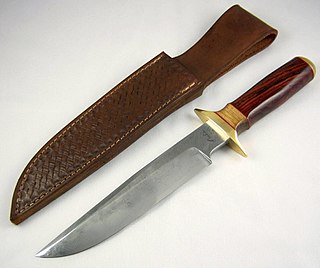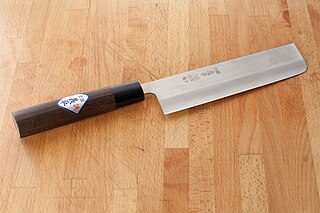
A knife is a tool or weapon with a cutting edge or blade, usually attached to a handle or hilt. One of the earliest tools used by humanity, knives appeared at least 2.5 million years ago, as evidenced by the Oldowan tools. Originally made of wood, bone, and stone, over the centuries, in step with improvements in both metallurgy and manufacturing, knife blades have been made from copper, bronze, iron, steel, ceramic, and titanium. Most modern knives have either fixed or folding blades; blade patterns and styles vary by maker and country of origin.

A chisel is a wedged hand tool with a characteristically shaped cutting edge on the end of its blade, for carving or cutting a hard material. The tool can be used by hand, struck with a mallet, or applied with mechanical power. The handle and blade of some types of chisel are made of metal or wood with a sharp edge in it.

A blade is the sharp, cutting portion of a tool, weapon, or machine, specifically designed to puncture, chop, slice, or scrape surfaces or materials. Blades are typically made from materials that are harder than those they are intended to cut. This includes early examples made from flaked stones like flint or obsidian, evolving through the ages into metal forms like copper, bronze, and iron, and culminating in modern versions made from steel or ceramics. Serving as one of humanity's oldest tools, blades continue to have wide-ranging applications, including in combat, cooking, and various other everyday and specialized tasks.

A Japanese kitchen knife is a type of kitchen knife used for food preparation. These knives come in many different varieties and are often made using traditional Japanese blacksmithing techniques. They can be made from stainless steel, or hagane, which is the same kind of steel used to make Japanese swords. Most knives are referred to as hōchō or the variation -bōchō in compound words but can have other names including -kiri. There are four general categories used to distinguish the Japanese knife designs: handle, blade grind, steel, and construction.

Nakiri bōchō and usuba bōchō are Japanese-style vegetable knives. They differ from the deba bōchō in their shape, as they have a straight blade edge suitable for cutting all the way to the cutting board without the need for a horizontal pull or push. These knives are also much thinner. While the deba is a thick blade for easy cutting through thin bones, the blade is not suitable for chopping vegetables, as the thicker blade can break the vegetable slice. The nakiri and the usuba have much thinner blades. This does not help with cutting small bones in fish or meat, but is useful for cutting vegetables.

Usuba bōchō is the traditional vegetable knife for the professional Japanese chef. Like other Japanese professional knives, usuba are chisel ground, and have a bevel on the front side, and have a hollow ground urasuki on the back side. Usuba characteristically have a flat edge, with little or no curve, and are tall, to allow knuckle clearance when chopping on a cutting board. Usuba literally means "thin blade" indicating its relative thinness compared to other knives, required for cutting through firm vegetables without cracking them. Due to its height and straight edge, usuba are also used for specialized cuts such as katsuramuki, shaving a vegetable cylinder into a thin sheet.

A blade's grind is its cross-sectional shape in a plane normal to the edge. Grind differs from blade profile, which is the blade's cross-sectional shape in the plane containing the blade's edge and the centre contour of the blade's back. The grind of a blade should not be confused with the bevel forming the sharpened edge; it more usually describes the overall cross-section of the blade, not inclusive of the beveled cutting edge which is typically of a different, less acute angle as the bevel ground onto the blade to give it a cross-sectional shape. For example, the famous Buck 110 hunting knife has a "hollow ground" blade, with concave blade faces, but the cutting edge itself is a simple, flat-ground bevel of lesser angle. It would be difficult, if not impossible, to put a "hollow grind" onto the actual cutting edge of the blade itself, which is a very narrow and small bevel.

A kitchen knife is any knife that is intended to be used in food preparation. While much of this work can be accomplished with a few general-purpose knives – notably a large chef's knife, a tough cleaver, a small paring knife and some sort of serrated blade – there are also many specialized knives that are designed for specific tasks. Kitchen knives can be made from several different materials.
In cooking, a chef's knife, also known as a cook's knife, is a cutting tool used in food preparation. The chef's knife was originally designed primarily to slice and disjoint large cuts of beef. Today it is the primary general utility knife for most Western cooks.

The santoku bōchō(Japanese: 三徳包丁, 'three virtues knife' or 'three uses knife') or bunka bōchō(文化包丁) is a general-purpose kitchen knife originating in Japan. Its blade is typically between 13 and 20 cm long, and has a flat edge. The santoku has and a sheepsfoot blade that curves down an angle approaching 60 degrees at the point. The bunka bōchō, however, has a k-tip. The term santoku may refer to the wide variety of ingredients that the knife can handle: fish, meat, and vegetables, or to the tasks it can perform: chopping, dicing, and slicing, with either interpretation indicating a multi-use, general-purpose kitchen knife. The term bunka, refers to how it is used for the cultural food of Japan. The blade and handle of the santoku are designed to work in harmony by matching the blade's width and weight to the weight of the tang and the handle.

Japanese carpentry was developed more than a millennium ago that is known for its ability to create everything from temples to houses to tea houses to furniture by wood with the use of few nails.
A serrated blade has a toothlike rather than a plain edge, and is used on saws and on some knives and scissors. It is also known as a dentated, sawtooth, or toothed blade. Many such blades are scalloped, having edges cut with curved notches, common on wood saws and bread knives.

Sharpening is the process of creating or refining the edge joining two non-coplanar faces into a converging apex, thereby creating an edge of appropriate shape on a tool or implement designed for cutting. Sharpening is done by removing material on an implement with an abrasive substance harder than the material of the implement, followed sometimes by processes to polish/hone the sharp surface to increase smoothness.

A butcher knife or butcher's knife is a knife designed and used primarily for the butchering or dressing of animal carcasses.

A cleaver is a large knife that varies in its shape but usually resembles a rectangular-bladed hatchet. It is largely used as a kitchen or butcher knife and is mostly intended for splitting up large pieces of soft bones and slashing through thick pieces of meat. The knife's broad side can also be used for crushing in food preparation and can also be used to scoop up chopped items.

Knife sharpening is the process of making a knife or similar tool sharp by grinding against a hard, rough surface, typically a stone, or a flexible surface with hard particles, such as sandpaper. Additionally, a leather razor strop, or strop, is often used to straighten and polish an edge.
This glossary of woodworking lists a number of specialized terms and concepts used in woodworking, carpentry, and related disciplines.

A cheese knife is a type of kitchen knife specialized for the cutting of cheese. Different cheeses require different knives, according primarily to hardness. There are also a number of other kitchen tools designed for cutting or slicing cheese, especially the harder types. These include the cheese cutter, cheese slicer, cheese plane, cheese scoop for soft cheese and others, collectively known as cheese servers.
A cimeter or scimitar is a large, curved butcher's knife, with a blade typically 8–14" (20–35 cm) long. It is used primarily for cutting large pieces of meat into retail cuts such as steaks. These knives are available with and without a granton edge. According to Webstaurant Store, a major supplier to the food industry, "Granton edge knives feature hollowed out sections running along both sides of the blade. When slicing meat, the grooves fill with fat and juices, which permits less contact between the meat and blade. Granton edge knives are often preferred for slicing thin portions of poultry, roasts, or ham."

A Chinese chef's knife — sometimes referred to as a Càidāo, a Chinese cleaver or a "chopper", is the rectangular-bladed, all-purpose cooking knife traditionally used in China, Vietnam, Cambodia and many other Asian countries to prepare a variety of meats, fish and vegetables. The popularity of this style of knife has spread with the associated cuisines. They resemble Western cleavers in appearance, but most Chinese chef's knives are relatively thin-bladed and designed for slicing, finely chopping and mincing vegetables, fish and boneless meats. The heavier gǔdāo are produced and are used much like Western-type meat cleavers to prepare large sides of beef, pork and other boned meats. However, Chinese-style knives of this weight are not common in the West.

















